Mark James E. (ed.). Physical Properties of Polymers Handbook
Подождите немного. Документ загружается.

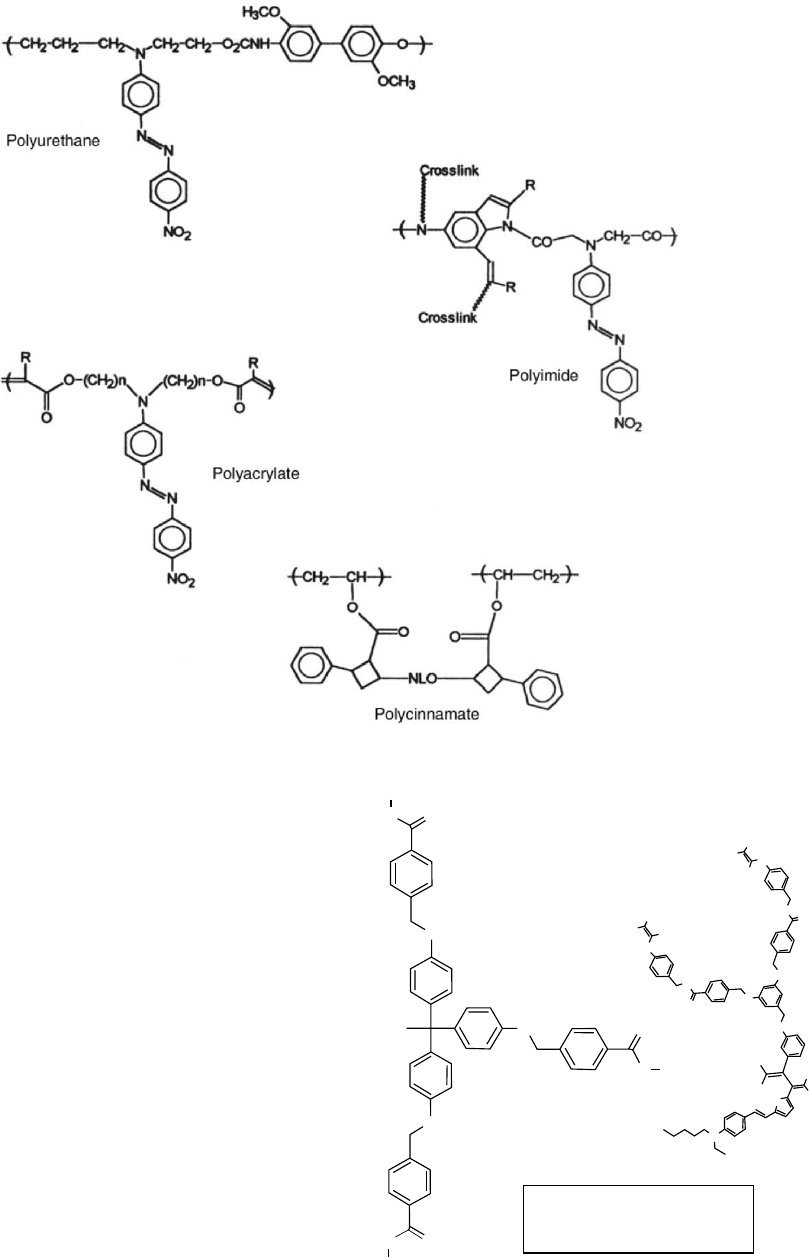
have also been used for NLO measurements. An example of
such a polymer is bisA-ANT [31]. This type of main-chain
polymer is expected to be easier to pole than the head-to-tail
main-chain polymers due to their enhanced flexibility. The
bulky tolane unit in bisA-ANT is supposed to improve the
temporal stability of the poled films. In fact, the decay of
polar order of bisA-ANT was found to be much better than
that of the analogous pNA polymer.
The temporal stability of poled NLO materials is consid-
erably improved by incorporating them in cross-linked sys-
tems (Fig. 49.6). Interesting results have also been obtained
recently by Dalton and co-workers in cross-linked poly(ur-
ethanes). In their study the NLO chromophore was poly-
merized with bifunctional isocyanate to obtain the
corresponding urethane polymer [32,33]. Both cross-linked
and non-cross-linked polymers show no thermal transitions
below 2708C. Although cross-linking can remarkably im-
prove the temporal stability of poled structures, thermal and
chemical cross-linking require processing of materials at
elevated temperatures. These temperatures sometimes tend
to degrade NLO chromophores. Therefore, an alternative
cross-linking procedure such as photochemical cross-link-
ing has been studied [34,35]. One such system is poly-
FIGURE 49.5. Continued
R
O
O
O
O
O
O
O
O
O
NC
NC
N
R ⫽
CN
CN
S
O
O
O
O
F
F
F
O
O
O
R
F
F
F
O
O
R
Chromophore density: 33 wt %
Mw: 4664
r
33
= 60 pm/V at 1.55 µm
FIGURE 49.6. Chemical structure of a multiarm cross-
linkable Nlo dendrimer.
802 / CHAPTER 49

(vinylcinnamate) doped with a NLO chromophore. In this
guest–host system it was possible to achieve a 20% loading
level of guest molecules without phase separation. Although
the T
g
of the system is found to be dependent on the chro-
mophore concentration, plasticization of the chromophore
was remarkably small. Absorption measurements indicate
that the polar order in the poled film persists for a long
period of time (many months) without any change [35].
Table 49.4 shows d
33
values obtained from poled films of
some side-chain polymers [36–43].
Also, the Langmuir–Blodgett (LB) technique has been
employed to prepare oriented thin films of organic polymers
for NLO investigations. An LB film containing 20 bilayers
of alternating monolayer of two different polymers yield a
thickness of 60 nm and a w
(2)
zzz
of 11:2 10
16
esu cm per
bilayer at 1:047 mm [44]. Molecular nonlinearity in this LB
film is supposed be arising from charge-transfer excitation
in the polymer with the sulfonyl group as the acceptor and
amino group as the donor. Optical waveguides capable of
guiding blue light with low loss (2---6 dB cm
1
) over several
centimeters have been fabricated from NLO polymers using
the LB technique. However, it was necessary to use another
NLO inactive polymer (t-butyl methacrylate polymer) as
buffer layer in order to prevent the formation of inversion
center in the film [45–48]. An LB film containing 168
bilayers (thickness 0:44 m m) showed waveguide attenu-
ation at 457.9 nm of 5.8 dB/cm for TE polarization and
2.6 dB/cm for TM polarization. The SHG measurements
on a 0.88-mm-thick LB film results in a w
(2)
zzz
value of
8 10
9
esu. Similar w
(2)
zzz
values (d
33
¼ 5:3 10
9
esu)
have been obtained for Langmuir–Schaefer films of meso-
genic moieties containing polysilane copolymers [49].
Current strategies for developing highly w
(2)
activities of
NLO polymers basically involve molecular design concepts,
same as presented in the previous sections. The key steps
are: (i) design of high mb chromophores; (ii) improvement
of temporal stability of NLO response in polymer matrices;
and (iii) poling efficiency of the polymeric systems [50].
Among these, the most important factor might be to design
highly efficient NLO chromophores. Therefore, to under-
stand the structure–property relationship of chromophores
with high w
(2)
values, quantum mechanical analysis based on
a simple two-level model description and bond-order alter-
nation principle have been investigated [51,52]. Table 49.5
shows values of mb at the off-resonance wavelength of
1907 nm for some representative chromophores, with im-
proved optical nonlinearity [53,54]. A large enhancement of
optical nonlinearity can be obtained by extending the length
of p-bridged chains with strong electron acceptor such as
the cyano group. It was shown that very large electro-optic
(E-O) coefficients could be achieved by introducing highly
efficient chromophores into amorphous polymer matrix
such as poly(methyl methaacrylate)(PMMA), polycarbon-
ate, polyquinoline, etc. [55–59]. In the case of PMMA added
with 17.5% of chromophore 10, the E-O coefficient was
reported to be r
33
¼ 105 pmV
1
at 1:33 mm [60]. This is
more than three times higher than that of lithium niobate
(LiNbO
3
; r
33
¼ 31 pmV
1
), which has been used as a ma-
terial for E-O modulators.
To improve the temporal and the thermal stabilities of
poled NLO dipoles, polyurethanes can be considered as one
of the best matrix materials, because of their extensive
formation of H-bonding between the urethane linkages
which would increase the rigidity of the polymer chain.
Several researchers succeeded in making greatly enhanced
NLO polymeric systems by using polyurethane backbone
[61–68]. Also, polyimides [69–80], polyetherimides
[81,82], polyamides [83–89], and polyesters [90–94] as
matrix polymers can also provide an enhanced thermal
stability of aligned dipoles due to high glass transition
temperature (T
g
) characteristics which also result in the
chain stiffness. By incorporating the NLO chromophores
into these polymer backbones, much improved long-term
thermal stability of NLO activity were obtained.
Another promising approach for making efficient NLO
systems is the employment of dendritic polymers [95–111].
Compared to common polymers, dendritic NLO polymers
can provide many advantages from the viewpoint of
structural variation, optimization of E-O values, thermal
stability, optical loss, etc. Jen’s group prepared a multiarm
TABLE 49.4. The NLO coefficient d
33
( ¼ 0:5x
(2)
333
) of poled main-chain NLO polymers.
Polymer d
33
(pm/V) l(mm) References
Polyurea 6.6 1.064 [29]
BisA-NAT 90 1.064 [35]
BisA-NAT 30 1.064 [35]
BisA-NPDA 13.5 1.064 [36]
d
31
¼ 3
Polyurethane 40 1.064 [37]
NLO chromophore tethered 120 1.064 [38]
Polyimide (NLO chromophore tethered) 4.6–5.5 1.064 [39]
NLO-chromophore-tethered acrylate 60 [40]
Polycinnamate: photocross-linked with
NLO chromophore
<11.5–21.5 1.54 [41,42]
NONLINEAR OPTICAL PROPERTIES OF POLYMERS / 803
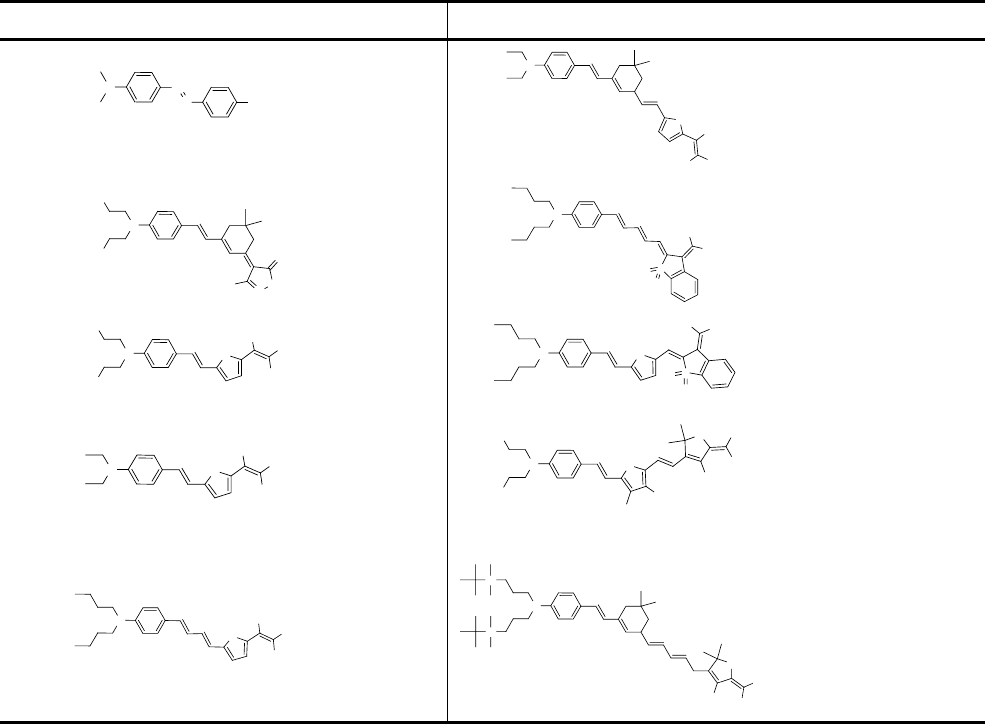
cross-linkable NLO dendrimer which consists of phenyl-
tetracyanobutadienyl thiophene-stilbene-based NLO chro-
mophore as the core and cross-linkable trifluorovinyl
ether-containing dendrons as the exterior unit (Fig. 49.6)
[99]. The maximum r
33
value of this system was found to be
60 pmV
1
at 1:55 mm and long-term alignment stability was
achieved for the poled dendrimer after thermal curing. It
retained over 90% of its original r
33
value at 85 8C for more
than 1,000 hours.
49.5 THIRD-ORDER NLO PHENOMENA
Third-order NLO effects are described by the macro-
scopic term w
(3)
IJKL
in Eq. (49.2). As in the case of second-
order NLO susceptibility, the third-order NLO susceptibility
w
(3)
IJKL
can be related to the microscopic third-order NLO
coefficient g
IJKL
via the following relationship [2,3]:
w
(3)
IJKL
¼ Nf
v
1
I
f
v
2
J
f
v
3
K
f
v
4
L
g
IJKL
, (49:12)
where N is the molecular number density and f
v
p
is the
appropriate local field factor. The g
IJKL
in the laboratory
fixed frame can be related to the molecular frame as
g
IJKL
¼
X
ijkl
a
Ii
a
Jj
a
Kk
a
Ll
g
ijkl
, (49:13)
where a
Ii
is the directional cosine between I and i of the
laboratory and molecular frame, respectively. Being a
fourth-rank tensor, w
(3)
IJKL
contains 81 elements [112]. How-
ever, the nonzero components of w
(3)
IJKL
depend on the sym-
metry of the molecule. Third-order NLO measurements can
conveniently be made on solution or in thin films of polymers.
In solution measurements an average over all directions
(orientations) has to be taken into account. For example, if
the solute molecules belongs to the orthorhombic point group
there are 21 nonzero components in the g
ijkl
tensor. If one
assumes Klienman symmetry [9] (g
xxyy
¼ g
xyxy
¼ g
xyyx
¼
g
yyxx
¼ g
yxxy
¼ g
yxyx
the number of independent elements
reduces to six, i.e., g
xxxx
, g
yyyy
, g
zzzz
, g
yyzz
, g
xxzz
, and g
xxyy
.
What is measured in experiments is the macroscopic third-
order NLO susceptibility w
(3)
IJKL
. For example, in the degener-
ate four-wave mixing experiment, when all the beams possess
the same polarization, one measures w
(3)
xxxx
( v ;v,v, v).
The third-order polarizability calculated from this measure-
ment is an orientationally averaged quantity, hgi, which can
be expressed as [113]
TABLE 49.5. The mb values of NLO chromophores with the extended -chain length and strong acceptor at the end of molecules.
NLO Chromophores µb (10
−48
esu) NLO Chromophores µb (10
−48
esu)
N
N
NO
2
N
1
580
N
S
NC
CN
CN
6
13,000
N
N
O
Ph
O
HO
HO
2
926
N
S
O
O
CN
NC
7
13,500
N
AcO
AcO
S
F
3
C(F
2
C)
5
F
2
C
CN
CN
3
3,300
N
S
O
O
CN
NC
S
8
15,000
N
S
NC
CN
CN
4
6,200
N
AcO
AcO
S
O
Bu
Bu
CN
CN
CN
9
18,000
N
S
NC
CN
CN
5
9,800
N
O
NC
NC
CN
Si
Si
10
35,000
804 / CHAPTER 49

hgi¼
1
5
(g
xxxx
þ g
yyyy
þ g
zzzz
þ 2g
xxyy
þ 2g
xxzz
þ 2g
yyzz
): (49:14)
There are several four-wave mixing techniques that can be
used to evaluate w
(3)
IJKL
components of a material [3]. It
should be noted that there are numerous third-order pro-
cesses that are described by different w
(3)
IJKL
terms. Hence, a
comparison of w
(3)
IJKL
derived from one technique with w
(3)
IJKL
evaluated with another technique should be made cau-
tiously.
49.6 THIRD-HARMONIC GENERATION
In general, the NLO polarization responsible for third-
harmonic generation (THG) can be given by [2,3]
P
I
(3v) ¼ w
(3)
IJKL
( 3v ;v,v,v)E
v
J
E
v
K
E
v
K
: (49:15)
THG is a coherent process and arises due to purely elec-
tronic contributions and does not depend on the population
of the excited state. However, the process can be resonantly
enhanced in the vicinity of one- or multiphoton absorption
bands. The THG intensity created in a sample can be
expressed as [2]
I
3v
¼
(3v)
2
n
3v
n
3
v
c
4
«
2
0
sin
2
[Dk(l=2)]
[Dk(l=2)]
2
jw
(3)
j
2
l
2
I
3
v
: (49:16)
As shown in Eq. (49.16) the THG intensity shows symmet-
rically damped oscillatory behavior near Dk ¼ 0. Unlike
SHG, phase matching is very difficult to achieve in THG
due to dispersion of the refractive indices. In the THG
experiment, the intensity of the sample is measured with
respect to a standard sample under identical experimental
conditions. Under the conditions D k 6¼ 0, the sample is
rotated around an axis perpendicular to the plane of inci-
dence, and the THG signal is recorded as a function of the
angle of rotation. The resulting THG fringes are analyzed to
obtain the coherent length of the material. Then the
w
(3)
IJKL
( 3v;v,v,v) of the sample is evaluated using the
following relationship [3]
I
3v, s
I
3v, r
¼
w
(3)
s
w
(3)
r
2
l
c, r
l
c, s
2
(49:17)
49.7 DEGENERATE FOUR-WAVE MIXING
In a degenerate four-wave mixing (DFWM) process,
three optical beams of the same frequency interact with the
material to create a fourth beam of the same frequency. The
NLO polarization responsible for this process can be given
by [2,3]
P
I
(v) ¼ w
(3)
IJKL
( v ;v,v, v)E
v
J
E
v
K
E
v
L
: (49:18)
Measurements of DFWM contain both real and imaginary
parts of w
(3)
IJKL
. This method is convenient and versatile in
measuring both electronic and dynamic nonlinearities and
their response times. The experiment can be performed
either in a forward (boxcar) geometry or in a backward-
wave geometry. In the case of the backward-wave geometry
the condition Dk ¼ 0 is automatically satisfied. In this
geometry two pump beams counterpropagate in the sample
(Fig. 49.7). The probe beam is incident on the sample.
The probe beam is incident on the sample at a small angle
with the two pump beams. The signal beam is obtained as a
phase conjugate beam (counterpropagating to the probe
beam), and it corrects every distortion of the probe beam
when it retraces it. The intensity of the signal beam for this
process is given by
I
s
¼
v
2
4n
2
c
2
jw
(3)
j
2
l
2
I
f
I
b
I
p
: (49:19)
Both pump beams are synchronized in time with their cross-
correlation, and the DFWM signal is studied as a function
of the time delay of the probe beam. For nonabsorbing
materials the w
(3)
value is calculated using the relationship
[3]
Laser
Delay Line
Beam 1
Sample
Signal
PIN Diode
Beam 2
Beam 3 (Probe)
Beam Splitler
Beam Splitler
Delay Line
FIGURE 49.7. Schematics of experimental arrangement of the degenerate four-wave mixing (backward geometry) experiment.
NONLINEAR OPTICAL PROPERTIES OF POLYMERS / 805
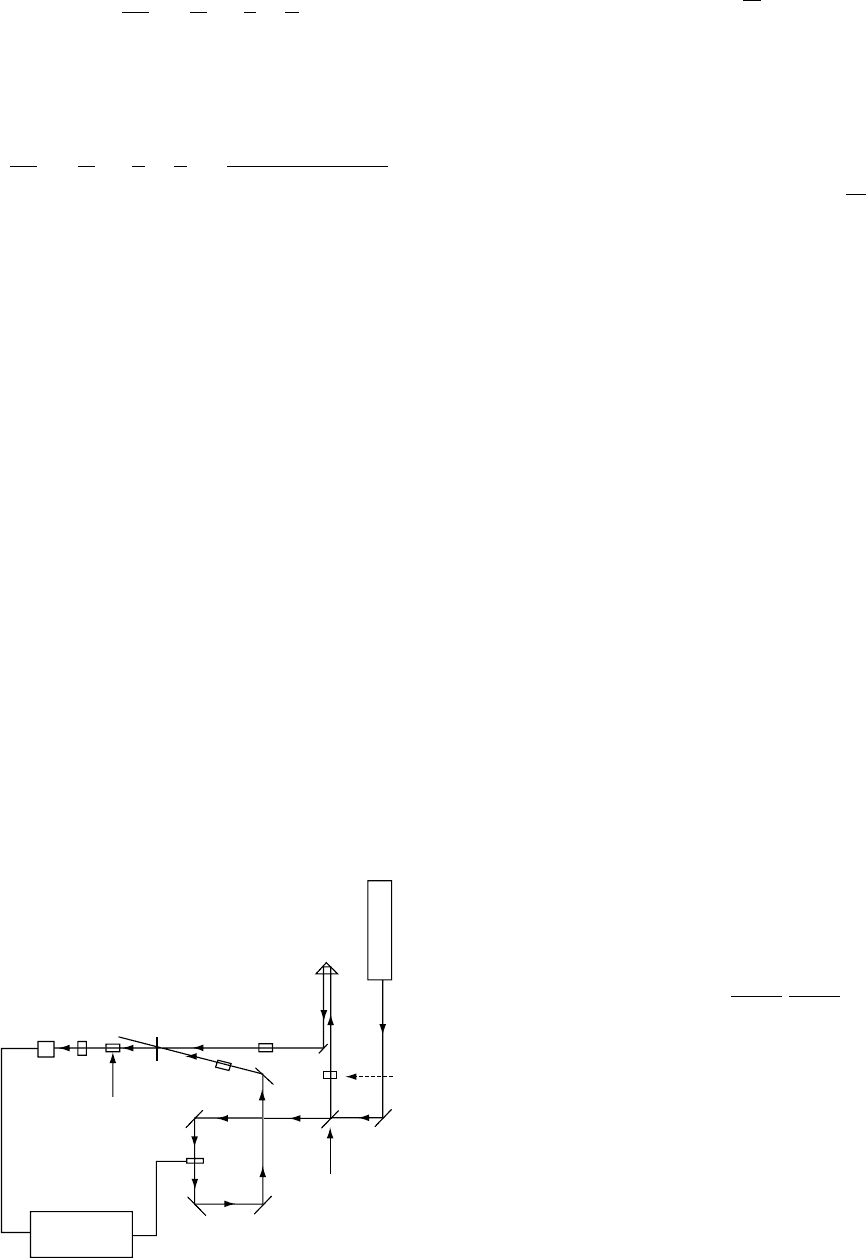
w
(3)
s
w
(3)
r
¼
n
s
n
r
2
l
r
l
s
I
s
I
r
1=2
(49:20)
For absorbing samples a correction should be made to com-
pensate the absorption losses; consequently, w
(3)
can be
calculated by the following relationship [3]:
w
(3)
s
w
(3)
r
¼
n
s
n
r
2
l
r
l
s
I
s
I
r
1=2
al
s
e
(al
s
=2)
(1 e
(al
s
)
),
(49:21)
where a is the linear absorption coefficient. In Eqs. (49.20)
and (49.21), I
s
and I
r
refer to intensities at zero time delay.
49.8 OPTICAL KERR GATE
The optical Kerr gate (OKG) is a process that arises due to
optically induced birefringence caused by a nonlinear phase
shift. The NLO polarization for the OKG can be expressed
as [2,3]
P
I
(v) ¼ w
(3)
IJKL
( v;v,v, v)E
v
J
E
v
K
E
v
L
: (49:22)
There are several different mechanisms such as electronic
deformation, molecular reorientation, electrostriction, mo-
lecular redistribution, and thermal change that are respon-
sible for the OKG process. Each of these mechanisms has its
own strength and response time, which generally differ from
each other. OKG measurements are usually performed by
the incidence of a strong pump beam (orienting beam) on
the sample. Then propagation characteristics of a weak
probe beam is studied as a function of the delay time (Fig.
49.8). Initially both beams are linearly polarized. To retrieve
the optical birefringence information the probe beam is
passed through an analyzer.
The optical birefringence created in the sample due to
penetration of strong pump beam can be expressed as
dn ¼ (dn
k
dn
?
) /
p
n
0
(w
(3)
xxxx
w
(3)
xxyy
): (49:23)
This birefringence is probed by the weak probe beam. By
delaying the probe beam, the time evolution of the process
can be studied. The intensity of the signal of the probe beam
through the Kerr gate as a function of the delay time can be
written as [3]
I
t
(t) ¼
ð
þ1
1
hE
2
probe
(t t)isin
2
dn
pl
2
dt (49:24)
Away from electronic resonances dn ¼ n
2
I
pump
. The quantity
n
2
can be obtained from the measurement at t ¼ 0 (peak
value). Therefore, w
(3)
xxxx
can be obtained assuming that w
(3)
xxyy
is very small. However, away from resonances, in an iso-
tropic medium a purely electronic nonlinearity leads to
w
(3)
xxxx
¼ 3w
(3)
xxyy
. In such a situation w
(3)
xxxx
can be directly evalu-
ated.
49.9 SELF-FOCUSING AND DEFOCUSING
Self-focusing and defocusing (SFD) also arise from the
intensity dependence of the refractive index of the medium
[114,115]. It is referred as self-action because the NLO
polarization created by the input beam changes its own
propagation characteristics. SFD does not provide any
information on response time. In general the intensity-
dependent refractive index responsible for SFD can be
written as
n(l) ¼ n
0
(l) þn
2
(l)I, (49:25)
where I is the intensity of the input beam and n
0
is the linear
refractive index. The NLO refractive index n
2
is related to
w
(3)
as shown in Eq. (49.26). The self-focusing occurs as a
combined effect of a positive n
2
and spatial variation of the
laser-beam intensity. If the laser-beam intensity at the center
of the beam is higher than that at the beam edges, a rela-
tively larger refractive index is resulted at the center. So the
sample acts as a positive lens and focuses the beam. Simi-
larly, self-defocusing occurs when n
2
is negative. The rela-
tionship between n
2
and w
(3)
is shown below:
n
2
(l) ¼
8p
2
cn
0
(l)
w
(3)
(l)
6
: (49: 26)
There are two different w
(3)
measurement techniques that are
based on self-action: (i) optical power limiter and (ii) the z
scan. In the case of the optical power limiter the laser beam
is focused in the sample with high n
2
. For low input powers
the transmitted beam is focused through a pinhole on the
detector. As the power increases the self-focusing starts so
that the focused beam is no longer focused through the
pinhole and the power after pinhole decreases. Beyond a
certain critical input power P
c
, transmitted power levels off
due to many other NLO processes. The critical power P
c
is
directly related to n
2
through the relation (for spatial Gauss-
ian beam) [116]
Lock-In
Amplifier
PIN Diode
Quater-wave
Plate
Chopper
Beam Splitter
Half-wave
Plate
Delay Line
Laser
Polarizer
Polarizer
Polarizer
Sample
FIGURE 49.8. Schematics of experimental arrangement of
the optical Kerr gate measurement.
806 / CHAPTER 49
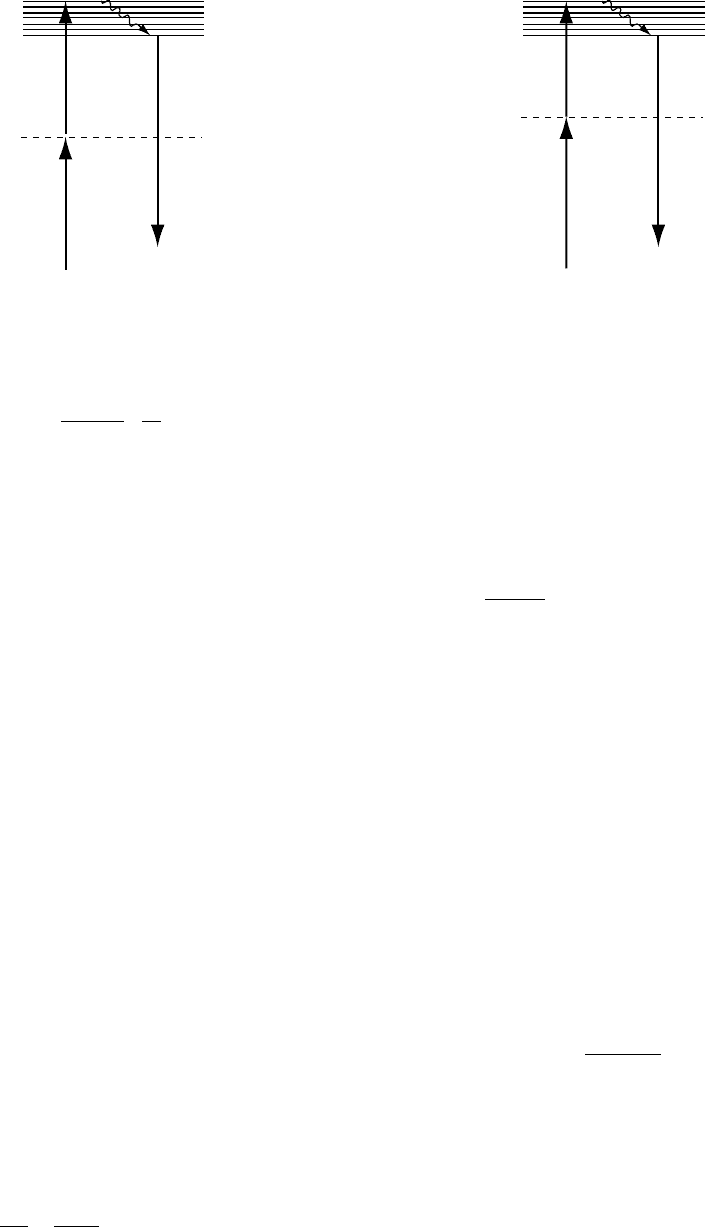
n
2
¼
3:72cl
2
32p
2
1
P
c
: (49:27)
Therefore, w
(3)
can be evaluated.
The z-scan method allows determination of both the mag-
nitude and the sign of n
2
[117]. In this technique a gaussian
beam is focused on the sample, and the transmitted power is
measured with a detector after passing the beam through a
pinhole kept at the far field. The sample is then moved
through the focus of the beam. Near the vicinity of beam
focus self-action may occur due to strong intensity. The
resultant plot of the intensity of the transmitted beam
through the pinhole yields a dispersionlike behavior from
which n
2
can be evaluated. The z-scan method is very
sensitive to the beam quality so that beam should be a pure
gaussian TEM
00
. Because of the high-power and long-inter-
action- length requirements, the z scan is more suitable for
the w
(3)
measurements of polymer solutions.
49.10 TWO-PHOTON ABSORPTION
The two-photon absorption (TPA) phenomenon was pro-
posed by Go
¨
eppert-Mayer in 1931 [118] and experimentally
first observed by Kaiser and Garrett [119]. TPA is one of the
important third-order NLO features. When a molecule is
exposed to an intense optical field such as from a pulse laser,
it can absorb two photons simultaneously by involving a
virtual intermediate state. Figure 49.9 schematically repre-
sent this process. If the two photons are of the same frequency,
the process is called degenerate TPA; if they are of different
frequency, the process is a nondegenerate TPA [120].
For a degenerate TPA process, the transfer rate of
absorbed energy can be expressed as [121]:
dW
dt
¼
8p
2
v
n
2
c
2
I
2
w
(3)
imag
, (49:28)
where I is the intensity of light, c is light velocity, n is
refractive index, v is optical frequency, and w
(3)
imag
is the
imaginary part of w
(3)
. Third-order NLO coefficient w
(3)
consists of a real part, w
(3)
real
, and an imaginary part, w
(3)
imag
,
i.e., w
(3)
¼ w
(3)
real
þ w
(3)
imag
.
From the above equation, the following theoretical ex-
pression for TPA coefficient (center dot) can be derived
because dW/dt is defined by multiplying the number of
photons absorbed per unit time with the energy of light
source, i.e., dW= dt ¼ (dn
photon
=dt)hv.
s ¼
8p
2
hn
2
n
2
c
2
N
w
(3)
imag
(unit: cm
4
GW
1
),
(49:29)
where N is the number of absorbing molecules per unit
volume. Also, s can be transformed into the following
equation for the use of common unit.
s
2
¼ shn
2
(unit: cm
4
sec photon
1
): (49:30)
In addition, TPA cross-section s
2
value is also expressed in
Go
¨
eppert-Mayer (GM) unit; 1 GM is defined as
1 10
50
cm
4
sec photon
1
.
The evaluation of TPA activity of the materials can be
made by various techniques such as up-converted fluores-
cence emission, nonlinear transmission, transient absorp-
tion, Z-scan, and four-wave mixing [122]. Among them,
the up-converted fluorescence emission method is a simpler
technique and the setup is shown in Fig. 49.10. In this
method, the TPA cross-section value, s
2
can be estimated
according to the following equation [123]:
s
2
¼
S
s
h
r
f
r
C
r
S
r
h
s
f
s
C
s
s
r
, (49:31)
where the subscripts s and r denote the sample and reference
compounds, respectively. The intensity of the two-photon
excited fluorescence emission signal collected by a PMT
detector is referred as S.Theh and f are the overall fluor-
escence efficiency and the fluorescence quantum yield, re-
spectively. The number density of the molecules in solution
is denoted as C. The s
r
is the TPA cross section value of the
reference. As a reference material, fluorescein or Rodamine
B is generally used [124]. The observed TPA cross-sections
of a large variety of organic and polymeric materials are in
Exited state (A**)
Virtual state (A*)
Ground state (A)
Exited state (A**)
Virtual state (A*)
Ground state (A)
V
1
V
2
V
2
V
1
Up-converted
fluorescence
emission
Up-converted
fluorescence
emission
Internal decay
Internal decay
(a) (b)
FIGURE 49.9 Two-photon absorption schemes. (a) Degenerate TPA process and (b) nondegenerate TPA process by simultan-
eous excitation of two-photons.
NONLINEAR OPTICAL PROPERTIES OF POLYMERS / 807

the range of several tens GM (1GM ¼ 1:0 10
50
cm
4
sec
photon
1
) to the order of 10
4
GM. The detailed TPA cross
section values of various materials are presented in Section
49.12.
By virtue of quadratic power dependence of the TPA pro-
cess, a tightly focused excitation beam can be used to induce
photochemical reactions such as photopolymerization and
photoisomerization in three-dimensions with high spatial
resolution. As a result, various photonic devices including
photonic crystals [125–128], optical data storage systems
[129–135], 3-D micro-waveguides [136–138], and micro-
electromechanical systems (MEMS) [139–142] have been
fabricated. In addition to this, the two-photon approach can
contribute to novel photonic and biophotonic applications
like two-photon upconverted lasing [143–150], optical power
limiting for the protection of human eyes and efficient sensors
against intense light [151–158], two-photon fluorescence
bioimaging [159–163], photodynamic therapy [164–170],
etc. A detailed general description of these potential applica-
tions using TPA techniques exists in the literature [122].
49.11 g AND w
(3)
VALUES OF POLYMERS
Electronic structural requirements for third-order NLO
polymers are different from those for second-order poly-
mers [3,4]. The third-order NLO properties are very sensi-
tive to the length of the p-electron conjugation. An
interesting third-order NLO polymer is polydiacetylene,
which can be prepared by solid-state polymerization (Fig.
49.11). The backbone of polydiacetylene is derived from a
diacetylene skeleton, R
1
C CC CR
2
, therefore, depend-
ing on the nature of substituents a variety of derivatives can
Ti:Sappire Laser
Monochromater
PMT
PD
OPO
Boxcar
HV
Lens
LDF
Lens
Cell
FIGURE 49.10. Schematics of experimental arrangement for
measuring
2
values by the up-converted fluorescence emis-
sion method.
TABLE 49.6. x
(3)
values of different forms and different derivatives of polydiacetylenes.
R
1
, R
2
x
(3)
(10
10
esu) Method References
R
1
, R
2
¼ CH
2
OSO
2
C
6
H
4
CH
3
(single crystal) 8.5 THG [56]
R
1
, R
2
¼ (CH
2
)
4
OCONHC
6
H
5
(single crystal) 1.6 THG [56]
R
1
, R
2
¼ CH
2
OSO
2
C
6
H
4
CH
3
90.0 DFWM [57]
R
1
, R
2
¼ CH
2
OSO
2
C
6
H
4
CH
3
2 10
5
SA [58]
R
1
¼ C
6
H
3
CF
3
CF
3
; R
2
¼ C
13
H
10
N 1.1 THG [59]
R
1
, R
2
¼ C
6
F
4
H
2
(CH
2
)
3
CH
3
1.2 THG [59]
R
1
¼ C
6
H
3
CF
3
CF
3
; R
2
¼ C
13
H
10
N (film) 4.3 EFISH [60]
R
1
, R
2
¼ (CH
2
)
3
OCONHCH
2
COOC
4
H
9
(film) 1.5 EFISH [61]
R
1
, R
2
¼ (CH
2
)
3
OCONHCH
2
COOC
4
H
9
(film) 0.13 DFWM [62]
R
1
, R
2
¼ (CH
2
)
3
OCONHCH
2
COOC
4
H
9
(film) 1.0 THG [63]
R
1
, R
2
¼ (CH
2
)
3
OCONHCH
2
COOC
4
H
9
2 DFWM [64]
R
1
, R
2
¼ (CH
2
)
3
OCONHCH
2
COOC
4
H
9
2.5 DFWM [64]
R
1
, R
2
¼ (CH
2
)
3
OCONHCH
2
COOC
3
H
7
9.0 DFWM [62]
R
1
, R
2
¼ (CH
2
)
3
OCONHCH
2
COOC
5
H
11
2.4 THG [63]
R
1
, R
2
¼ C
13
H
10
N (film) 0.7 THG [65]
R
1
, R
2
¼ C
13
H
10
N (oriented film) 6.0 THG [66]
R
1
, R
2
¼ (CH
2
)
4
OCONH(CH
2
)
n1
CH
3
17.0 THG [67]
R
1
, R
2
¼ CH
3
(CH
2
)
15
C C ¼ C C(CH
2
)
8
COO 0.56 THG [68]
R
1
, R
2
¼ CH
3
(CH
2
)
15
C C ¼ C C(CH
2
)
8
COO 0.08 THG [69]
R
1
, R
2
¼ C
6
H
3
CF
3
CF
3
(film) 0.4 THG [59]
R
1
¼ C
6
H
3
CF
3
CF
3
;R
2
¼ C
6
H
4
NHCH
3
(film) 8.0 THG [70]
R
1
R
1
R
1
R
1
Polydiacetylenes
R
2
R
2
R
2
R
2
1
)
n
(
FIGURE 49.11. Molecular structures of the NLO polymers
described in Table 49.5.
808 / CHAPTER 49

be obtained. Table 49.6 shows w
(3)
values of a series of
polydiacetylenes measured with different techniques at dif-
ferent wavelengths [171–185]. As seen in Table 49.6 the
resonantly enhanced w
(3)
of polydiacetylene can be as high
as 10
5
esu, the largest third-order nonlinearity for an or-
ganic observed to date.
Another interesting conjugated polymer is polythiophene,
which has good environment stability compared to polyace-
tylenes (Fig. 49.12) (Table 49.7). Polythiophene has a w
(3)
value of 3 10
11
at a wavelength of 1:06 mm. The reson-
antly enhanced value is about 2 orders of magnitude larger
than the nonresonant value. Table 49.7 shows w
(3)
values of
a polythiophene derivatives. Polythiophenes are colored
materials [186–193]. The w
(3)
behavior of polythiophene
has been studied in several forms. Electrochemically poly-
merized films of polythiophene results a w
(3)
value of
4 10
10
esu as measured by DFWM at 602 nm [194]. A
monolayer prepared by the LB technique (thickness 22 A
˚
)
yields a w
(3)
value of 10
9
esu at 602 nm as measured with
femtosecond DWFM technique [195].
Polyacetylene is another interesting p-conjugated one-
dimensional polymer that exists in two geometrical forms:
cis and trans [196]. In polyacetylene the w
(3)
value of the cis
form is found to be 15–20 times smaller than that of trans
form. The difference in w
(3)
for the two forms results from
the fundamental difference in the polymer symmetry. Also,
oriented films of polyacetylene exhibit larger w
(3)
values
than unoriented films [197]. Polyketene, in which acetylene
hydrogens are substituted with hydroxy groups, shows a
w
(3)
value of 1:15 10
12
esu at 532 nm [198]. In polyphe-
nylacetylene substitution at the phenyl ring increases w
(3)
significantly [199]. An ortho-trimethylsilyl-substituted
polyphenylacetylene has a w
(3)
value, which is an order of
magnitude larger than the w
(3)
value of polypphenylacety-
lene.
The w
(3)
values of polyphenylacetylene and several other
polymers such as poly-p-phenylenevinylene (PPV), PBT,
PBO, LARC-TPI, polyketene, polyaniline, polyazine, and
polypyrrole are shown in Table 49.8 (Fig. 49.13). Also,
included in Table 49.8 are w
(3)
of several heterocyclic ladder
polymers. Polyazine is an NLO polymer that is isoelectronic
with polyacetylene. Both polyazine and polyacetylene have
a simple one-dimensional chain of alternating single and
double bonds. In the case of polyazine, pairs of N are
substituted for pairs of C in the backbone. Even though the
optical nonlinearity of polyazine is moderate, its optical
transparency and environmental stability are great advan-
tages.
Good-optical-quality polymers of PPV and poly-p-thie-
nylene vinylene (PTV) can be prepared from soluble sulfo-
nium precursors. This feature allows one to fabricate a
device structure with the precursor and then convert it to
the polymer by heat treatment. Good-optical-quality,
stretchoriented, free-standing films of PPV can be obtained
with good mechanical strength and high optical damage
thresholds. In stretched films, doping produces high elec-
trical conductivity along the draw direction, indicating a
high effective p-conjugation in polymer. Singh, Prasad,
and Karasz [201] studied the anisotropy of w
(3)
in a stretched
PPV film by measuring the DFWM signal as a function of
the angle of rotation (Fig. 49.14).
7
The highest w
(3)
value is
obtained when electric fields of all the four waves are
polarized along the draw direction, while the minimum
value is obtained when all the beams are polarized in a
direction perpendicular to the draw direction. The ratio of
w
(3)
k
: w
(3)
?
was 39 obtained by fitting the experimental data to
the following expression:
w
(3)
1111
,L
¼ w
(3)
1111
,F
cos
4
u þ w
(3)
2222
,F
sin
4
u þ (w
(3)
1122
,F
þ w
(3)
1221
,F
þ w
(3)
2122
þ w
(3)
1212
,F
þ w
(3)
2211
,F
þ) cos
2
u sin
2
u: (49:32)
TABLE 49.7. x
(3)
values of different forms and different derivatives of polythiophenes.
Polymer l(mm) x
(3)
(10
10
esu) Method References
Polythiophene 0.532 10 DFWM [71]
R ¼ H 1.907 3.52 THG [72]
R ¼ C
12
H
25
0.602 0.55 DFWM [73]
R ¼ C
12
H
25
0.602 5.0 DFWM [74]
R ¼ C
12
H
25
0.602 5.0 DFWM [75]
R ¼ CH
3
1.50 0.48 THG [76]
R ¼ C
4
H
9
1.50 0.2 THG [77]
R ¼ C
6
H
5
1.50 0.81 THG [76]
PTV 1.85 0.32 THG [78]
Polythiophene (electrochemical) 0.602 0.07 DFWM [79]
Polythiophene (LB film) 0.532 2700 DFWM [80]
PTVPolythiophene
S
n
R
S
n
FIGURE 49.12. Molecular structures of the NLO polymers
described in Table 49.6.
NONLINEAR OPTICAL PROPERTIES OF POLYMERS / 809
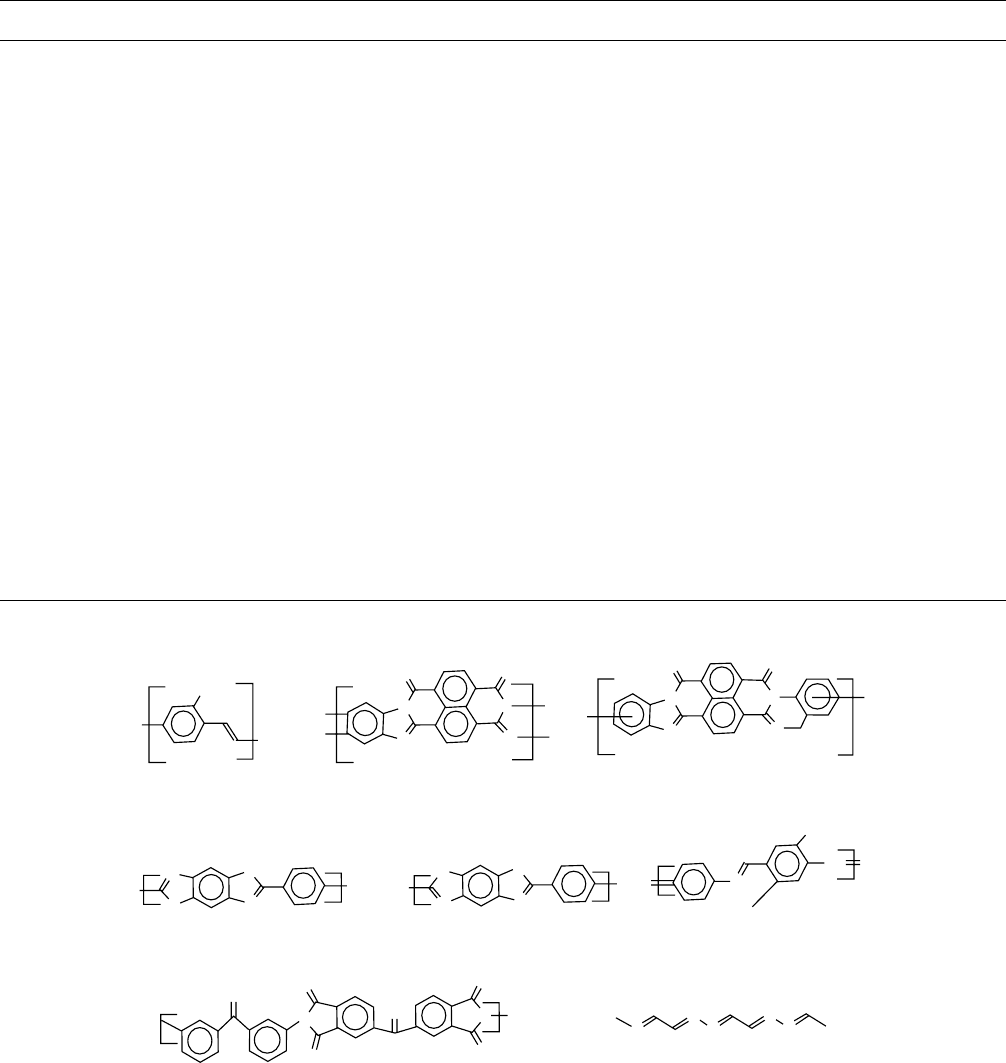
Similar results also has been obtained by Swiatkiewicz and
co-workers [205] in stretch-oriented films of poly-(2,5-
dimethoxy-p-phenylenevinylene) thin films. Also, oriented
films of PPV have been fabricated with the LB technique
[201]. The w
(3)
value (at l ¼ 1:064 mm) of an LB film of poly-
(2,5-dimethoxy-p-phenylenevinylene) is 2:9 10
9
and
7:5 10
11
esu along the orientation axis and perpendicular
to the orientation axis, respectively. The above investigations
show that, as in polydiacetylenes, the chain orientation is an
effective way of enhancing w
(3)
of PPV and its derivatives.
PPV
PBT
LARC-TPI
PBO Polyazomethine
Polyazine
BBL BBB
N
N
N
N
N
H
29
C
14
O
OC
14
H
29
N
CH
n
N
N
n
O
O
O
O
O
O
N
N
n
O
O
R
n
N
N
S
S
n
N
N
N
N
O
O
n
N
N
N
N
O
O
n
FIGURE 49.13. Molecular structures of the NLO polymers described in Table 49.8.
TABLE 49.8. x
(3)
values of a number of third-order NLO polymers.
Polymer x
(3)
(10
12
esu) l(mm) Method References
PBT 100.0 0.602 DFWM [200]
9.0
PBO 100.0 0.602 DFWM [179]
PPV (stretch-oriented) 400.0 0.620 DFWM [201]
PPV (R ¼ H) 75 1.064 THG [202]
PPV (R ¼ OCH
3
) 2900 1.064 THG [203]
PPV (sol–gel) 45 0.620 DFWM [204]
PPV (sol–gel) 6.6 0.620 OKG [204]
MOPPV (stretch-oriented) 91 0.608 DFWM [205]
PPV (sol–gel) 300 0.602 DFWM [206]
MOPPV (LB film) 2900 1.064 THG [207]
Polyphenyl acetylene 50.0 0.602 DFWM [179]
LARC-TPI 2 0.602 DFWM [179]
Poly-4-BCMU, yellow 25.0 0.602 DFWM [179]
Poly-4-BCMU, red 300.0 0.602 DFWM [179]
Polyketene 1150 0.532 THG [198]
Polyaniline 800 0.620 DFWM [208]
Polypyrrole 2 0.602 DFWM [209]
BBL 7 0.602 DFWM [210]
150 0.620
BBB 4500 1.064 DFWM [210]
Polyazomethine 2.4 0.602 DFWM [211]
Polyquinoline 2.2 2.38 THG [212]
Polyquinoxaline 4500 0.532 DFWM [213]
Polyazine 8 1.5 THG [214]
810 / CHAPTER 49

Another interesting feature of PPV is that it can be in-
corporated into sol–gel glasses (up to 50 wt %) without
phase separation. Sol–gel composites of PPV have been
prepared using SiO
2
and V
2
O
5
gels [206]. A light beam at
1:064 mm can be guided in a sol–gel processed PPV film
(thickness 1 mm) up to 2 cm with a loss of 4 dB/cm.
The refractive indices (n
TE
¼ 1:72 and n
TM
¼ 1:60 at
1:064 mm) indicate the presence of birefringence even in
as cast film [215,216].
Another important class of photonic materials is polysi-
lanes (Fig. 49.15) [217–222]. In polysilanes the delocaliza-
tion of s orbitals of the Si atom along the polymer backbone
plays a significant role in their NLO properties. Their phys-
ical and chemical properties can be tailored by the choice of
an appropriate substituent, which also determines the con-
formation of the polymer and its solubility. What is of more
interest is their transparency in their NLO properties. w
(3)
values of a series of polysilanes are given in Table 49.9.
Tables 49.10–49.13 contain g and w
(3)
values of some other
third-order materials, namely metallophthalocyanine, bis-
metallophthalocyanine, metallonaphthalocyanines, fuller-
enes, and b-carotenes. Although these molecules are not
considered as polymers, they are macromolecules that
have drawn a considerable amount of attention as third-
order NLO materials. For example, the highly stable icosa-
hedral-cage C
60
molecule (fullerene) has been studied by a
large number of research groups as a third-order NLO ma-
terial. Fullerene is considered to be a new form of carbon in
that it possesses a soccer ball structure. All the carbon atoms
in fullerene are connected with sp
2
bonds and 60 p electrons
are distributed in a manner giving the molecule a highly
aromatic character. The interesting p conjugation in fuller-
enes has made it an important candidate for thirdorder NLO
optics. Table 49.10 reports the NLO properties of fullerenes
measured by different research groups. Other highly conju-
gated molecules can be considered as one-dimensional (b-
carotene) and two-dimensional (phthalocyanines and
naphthalocyanines) for NLO purposes.
49.12 TPA CROSS-SECTION VALUES OF
ORGANICS AND POLYMERS
The basic structural requirement as a TPA material is p-
conjugation of the molecule, because the TPA process ori-
ginates from third-order NLO activity. At the initial stage of
TPA research, only commercial chromophores such as fluor-
escein, coumarin 307, Rodamine B, etc., were reported to
exhibit TPA activities, but they all exhibited relatively low
TPA cross-section s values (< 200 GM) which is expressed
in Go
¨
eppert-Mayer (GM) units (1GM ¼ 1 10
50
cm
4
sec photon
1
) [124]. To address this problem, several re-
search groups focused attention on synthesizing materials
with high TPA cross-section. This entailed an improved
understanding of the structure–property relationship. In par-
ticular, there have been intense efforts to identify contribu-
tions from different structural models of a molecule on the
TPA cross-section. Systems with symmetrical donors
(donor–p–bridge–donor; D–p–D) and acceptors (acceptor–
p–bridge–acceptor; A–p–A) as well as asymmetrical struc-
ture having both donor and acceptor (donor–p–bridge–ac-
FIGURE 49.14. Polar plot (orientational anisotropy) of the
square root of the DFWM signal intensity for the 10:1 stretch-
oriented PPV film. Scattered are the experimental data points;
continuous line is the theoretical fit [201].
TABLE 49.9. x
(3)
values of polysilane derivatives.
Polymer
x
(3)
(10
12
esu) l(mm) Method References
PEPS 5.3 1.064 THG [217]
PDHS 11.3 1.064 THG [221]
1.3 1.907
PDIHS 1.8 1.064 THG [217]
PPMS 1.5 1.064 THG [220]
7.2 1.064 THG [219]
4.2 1.907 THG [219]
POMS 2.9 0.532 THG [218]
PtBuPS 4.9 1.064 THG [217]
PSM-MSM 3.6 1.064 THG [221]
PSM-n-HSM 3.1 1.064 THG [221]
Polycarbosilane 0.34 1.064 THG [221]
PHPnS 2.3 1.064 THG [217]
PHPS 6.2 1.064 THG [217]
PDES 3000 0.620 DFWM [222]
PDHS : R
1
= R
2
= C
6
H
11
PEPS : R
1
= C
2
H
5
PPMS : R
1
= CH
3
R
2
= C
6
H
5
R
2
= C
5
H
11
POMS : R
1
= CH
3
R
1
= C
6
H
13
R
1
= C
6
H
13
R
2
= C
5
H
11
R
2
= C
6
H
5
PHPnS :
PHPS :
R
2
= C
6
H
17
R
1
R
2
Sl
n
Sl
R
2
R
1
FIGURE 49.15. Molecular structures of the NLO ploymers
described in Tables 49.9.
NONLINEAR OPTICAL PROPERTIES OF POLYMERS / 811
